On an average day in 2020, roughly 500 million people watch Instagram Stories while 186 million people log into Snapchat.
While platforms like Instagram and Snapchat have taught us how entertaining social media Stories can be to the average person, LinkedIn's product team is now wondering if this content can also be intriguing to business professionals.
In February, LinkedIn announced that it was beginning to internally test a new Story feature on its platform.
While LinkedIn Stories is just an experiment at this point, the online networking company says that this endeavor comes after other major social networks like Instagram, Facebook, and Snapchat have succeeded and drawn in new audiences to their platforms with Stories.
"Last year, we started asking ourselves what Stories might look like in a professional context. Stories first appeared on Snapchat, with other platforms like Instagram and Facebook adopting them soon after," Pete Davies, LinkedIn's head of Consumer Products wrote in a blog post. "They spread for a good reason: they offer a lightweight, fun way to share an update without it having to be perfect or attached to your profile forever."
"Does that exist in the business world? I’d hope that most of my interactions in the break room or passing people in the hall are similarly ephemeral and light," Davies added. "The same holds true for cubicle and coffee shop banter around the world: sometimes we want a way to just make a connection, have a laugh with our colleagues and move on."
Aside from following the lead of Instagram, Facebook, and Snapchat to see if Stories can be successful for its current audiences, LinkedIn's product team is also interested in learning if Stories could help them attract and provide value to younger professionals.
"There’s an entire generation growing up with Stories as a way of speaking; they’re more comfortable starting conversations with a full-screen ephemeral format than posting updates and prefer sharing content that lives as a moment in time rather than as an item in a feed," Davies explained.
Although this feature, which LinkedIn hopes to roll out in the coming months, might be new to professionals, it is not the first time the platform has dabbled in Stories.
In 2018, LinkedIn also launched a similar experiment called Student Voices. With this feature, students on the platform could share and watch Story formatted updates related to academia, their current projects, or thoughts related to school. Here's a quick screenshot of what this layout looked like for students on the platform
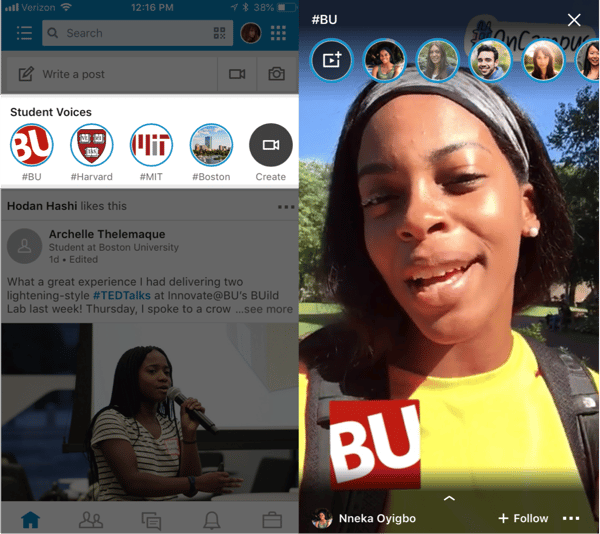
While LinkedIn has not explained what the Stories feature will look like or if it will be similar to the Student Voices feature, their announcements have led bloggers and publications to suggest that it will be similar to Story formats on Snapchat, Instagram, and Facebook Stories.
But, even if the format is similar and easy to pick up quickly, as a marketer, you might be wondering, "How can I leverage this new feature for LinkedIn audiences specifically?"
In this blog post, I'll highlight a few marketing opportunities that LinkedIn Stories could provide to businesses or thought leaders on LinkedIn.
Even if LinkedIn Stories doesn't come to fruition, you can also experiment with these tips on platforms like Instagram Stories -- which have large audiences at various career levels. For each marketing opportunity discussed, I'll give an example of how a brand has done it on another Story platform. This could give you added inspiration so you can begin executing on successful strategies if and when the feature launches.
5 Ways You Could Leverage LinkedIn Stories
1. Inform audiences about topics related to your industry.
Aside from using LinkedIn to update digital resumes and look for jobs, many people browse their LinkedIn feed for insights related to their industry.
While some brands have already tried creating Story content on Instagram and Facebook to inform followers about an industry topic, this type of niche content might be even more valuable to Linkedin users who visit the site to learn about their field.
Here's an example of an Instagram Story where the MIT Technology Review highlights the biggest tech fails of 2019. To add to the user experience, the story also swipes up to fuller content on its website.
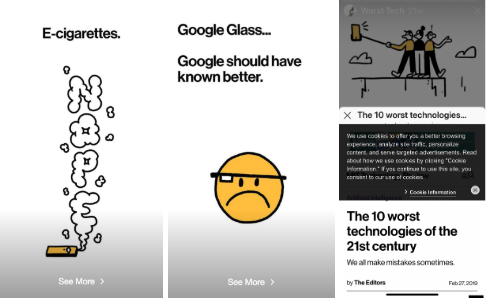
2. Adapt blog content to a Stories format.
Not sure where to start with a Stories feature? Consider leveraging the text-based content you already have to create a guideline for a Story.
For example, if you've written a listicle or step-by-step guide-styled blog posts, you can consider making each step or list item a page of your Story, By doing this, people who are interested in learning about your blog topic who don't want to leave the app can still consume it in a mobile format.
While this tactic is a good way to promote your blog or other content, it also allows social media followers to see that your brand offers credible information to professionals within your industry.
Adapting content to Story format is a tactic commonly used by Harvard Business Review which regularly publishes Stories on Instagram and Facebook based off of their web articles:
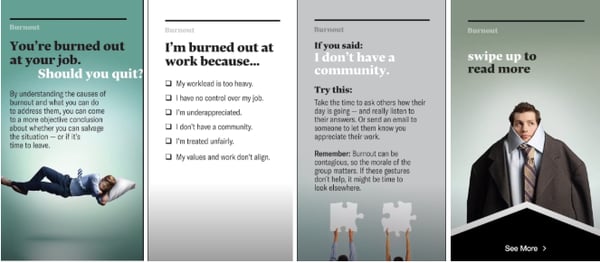
3. Share videos or Q&As featuring thought leaders in your community.
On LinkedIn, people love to follow thought leaders. If you've been on the platform for a long time, there's a good chance that you're following at least one in your industry.
One way to pull LinkedIn viewers into Story content could be to feature a thought leader with a decent following on the platform in your Story to talk about an interesting topic. This will both allow you to bring awareness to your brand while also cross-promoting with the chosen thought leader.
Here's a great example of how HubSpot published an Instagram Story Q&A with one of its social media video editors. With this example, the thought leader not only offered marketers valuable information, but audiences were also able to interact with him by asking their burning video marketing questions.
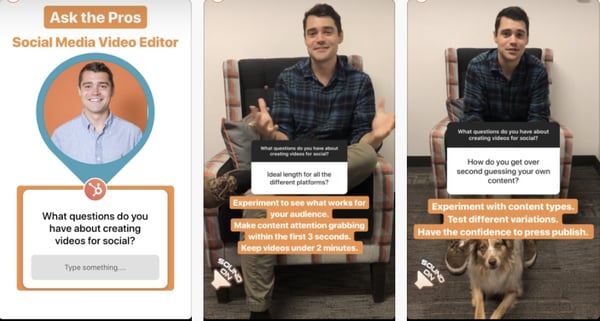
4. Sharing videos of customer testimonials.
As each new generation becomes more mobile, so does their product research. But, despite the change of platforms, younger generations are like older age groups in that they trust recommendations more than any other type of content marketing.
As millennials become company decision-makers and Gen-Z enters the workforce, odds are that they'll eventually be looking for a product with great reviews that's been proven to make professional work easier. This is why filming happy customers on your Story could be a great strategy on a channel like LinkedIn or Instagram.
Here's one screenshot from a Story featured on both Instagram and Facebook where a customer of a small Dublin-based Invisalign company discusses her tooth-straightening success story.
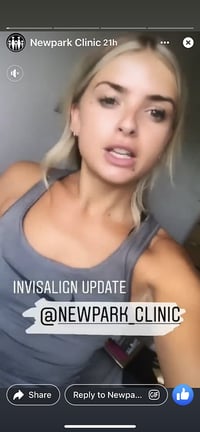
5. Creating interactive content related to your content or industry.
Although we don't know what LinkedIn Stories will look like, Facebook and Instagram Stories allow interactive features such as Quiz and Poll Stickers.
If you're able to use these types of features on LinkedIn, they could allow your viewers to engage with an industry topic or trend insights in a new way. Features, like Polls, could also help you learn more about the audience that heavily uses the Story feature.
Here's one example of how HubSpot educated users on email etiquette with an interactive Story modeled like a quiz:
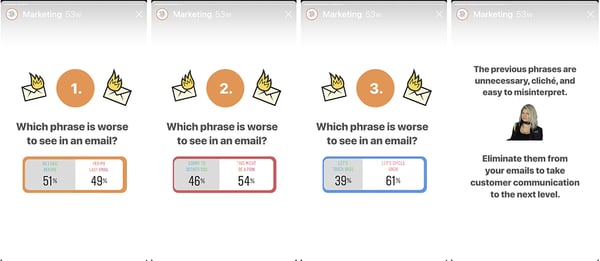
Navigating All the Social Media Stories
The biggest takeaway from LinkedIn's Stories test isn't necessarily that the platform is adding a new feature. This move highlights how powerful social media Stories are, and how this trend isn't going away any time soon.
Even if LinkedIn doesn't go through with launching this tool, this test shows that marketers and brands might want to spend more time testing out Story strategies on platforms that their audiences are frequently visiting.
From what has been reported, it seems like LinkedIn Stories will be a similar platform to Instagram and Facebook Stories features. If you've already leveraged those tools to market your brand, LinkedIn Stories might not be that big of a stretch for your business. When and if LinkedIn Stories does launch, it could be helpful to test certain Stories on all three platforms, while also posting a few Stories that were specifically for each network.
By testing the same Story content on multiple platforms -- as well as creating experimental content that caters to just one network, you can identify examples of content that will engage all multiple Story audiences while also learning how to zone in on engaging your LinkedIn audience specifically. This could also be helpful when attempting to create a scalable Story strategy that will allow you to launch successful content on all the platforms.
To learn more about how to create social media Stories, check out this blog post on the most engaging Instagram Story formats, as well as this piece that highlights the differences between Instagram, Facebook, and Snapchat Stories.
from Marketing https://ift.tt/2yGi6C0
via
No comments:
Post a Comment